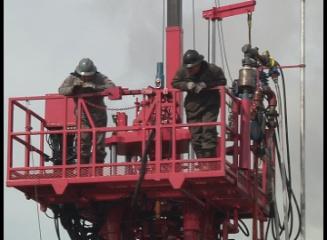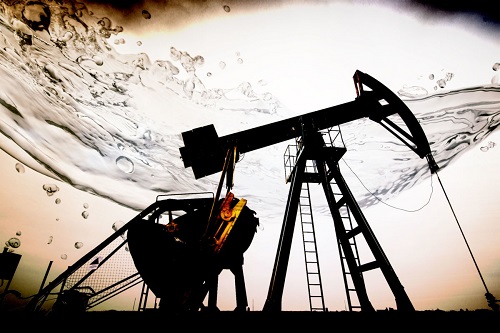
Worries Growing About Dangers Oil Field Workers Face
February 18, 2019US Judge Halts 100’s of Drilling Projects in Groundbreaking Climate Change Ruling
March 21, 2019By Melissa Troutman, Truthout, February 21, 2019
They’ve spread it on roads. They’ve irrigated almond farms and fruit groves with it. The oil and gas industry’s liquid waste has been used for a variety of commercial and industrial purposes over the years. But never has the “beneficial use” of this waste stream been so grossly applied, or so close to home, as it is today.
Meet Eureka Resources and Nature’s Own Source. Both of these companies have attracted attention by processing liquid waste from oil and gas operations and creating commercial products for use in pools and on roads, sidewalks, patios, stairs or anywhere else a consumer may put it.
Eureka Resources
Eureka Resources treats toxic wastewater from drilling and fracking for natural gas in Pennsylvania, and the agency that approves this is the Pennsylvania Department of Environmental Protection (PADEP). In June 2014, Eureka Engineer Jerel Bogdan wrote to PADEP to confirm what, exactly, the company had to do in order to sell the salt byproduct from the company’s waste treatment process to consumers.
But instead of listing what Eureka had to do, the letter confirmed what Eureka didn’t have to do — like test its salt for fracking chemicals, even though in 2017, Yale Public Health found that 55 unique chemical compounds used for fracking are “known, probable, or possible human carcinogens.”
Here are the four standards Eureka must adhere to, according to Bogden’s letter to PADEP (emphasis added):
- A full chemical equivalency analysis of Eureka salt products vs. the salt material currently in use by a given industrial user is not required.
- Eureka is required to maintain analytical data/records on file that confirm the salt product meets only those qualitative requirements listed on the MSDS [Material Data Safety Sheet] for the salt material that a potential buyer is currently procuring from other suppliers.
- Eureka is not required to use an accredited third-party analytical laboratory for the qualitative comparison noted above; in-house analytical resources may be used for the comparison if Eureka can demonstrate that those resources are able to generate data sufficient for all parameters included in the comparison.
- Eureka is not required to submit the qualitative comparison data to the PADEP for review but rather is required to maintain data/analytical results on file, to be provided upon request by the PADEP.
So, who is buying Eureka’s frack salt?
Cargill purchased 4,700 tons of salt from Eureka between May 2015 and December 2016. One of Cargill’s meat processing plants, Cargill Meat Solutions in Wyalusing, Pennsylvania, is less than 10 miles away from Eureka’s wastewater treatment facility, and “processes about 1,500 head of cattle per day,” according to Cargill’s website.
In an email, PADEP wrote that Cargill “advised the Department” that Eureka’s “[c]rystallized sodium chloride” is used by Cargill “to prepare and treat animal hides, resulting from Cargill’s meat packing operations. Cargill prepares the animal hides using one of Eureka’s salt products for commercial sale.”
Eureka’s frack salt is also approved for sale as a pool salt. The investigative news team at Public Herald exposed that Eureka’s byproduct is packaged and sold as Clorox Pool Salt. Workers at Eureka’s Standing Stone facility package the salt in Clorox bags and pallet them for shipment via an “unnamed third-party distributor to be sold at regional stores like Wal-Mart, Home Depot and Lowes.”
Eureka tests its frack salt quarterly, but there is no testing of the product for radioactivity and other toxins on a more routine basis. This concerns Daniel Bain, a research professor at University of Pittsburgh’s Department of Geology and Environmental Science who studies radioactivity. Bain told Public Herald that “all it takes is a little glitch in the process, and you can have a dirty salt at some point.”
Finally, according to PADEP engineer Lisa Houser, the Department has also approved a “Mixed Brine Solution” by Eureka “for use at oil and gas well sites.” According to Waste Management Program Director Ali Tarquino Morris, PADEP additionally approved Eureka’s “Evaporated Salt” for use as road salt.
How Frack Salt Gets Approved in Pennsylvania
You may be wondering how a company like Eureka could get away with repackaging byproducts from fracking and selling them without informing the public about what they really are. But the process is perfectly legal in Pennsylvania through a regulatory mechanism called “de-wasting.” De-wasting essentially means rebranding waste as a new product, often without significant treatment to remove health and environmental hazards.
A company can de-waste its fracking wastewater under a permit called the WMGR123. According to PADEP, oil and gas liquid waste that has been processed under the WMGR123 permit “is not considered a waste” as long as it meets “the concentration limits in Appendix A” of the permit. “Appendix A” imposes limits on some of the nasty stuff in fracking waste, such as uranium, arsenic, benzene and lead. But there are no limits or even testing required for the more than 1,000 different chemicals used for fracking to ensure they don’t end up in repackaged byproducts.
Nature’s Own Source
Another product of concern is manufactured in, and approved by, Pennsylvania’s neighbor to the west — Ohio — also a shale gas and oil production state.
In 2003, Duck Creek Energy began manufacturing a de-icing product from its oil and gas wastewater called AquaSalina. According to a press release, AquaSalina was approved by Ohio Department of Natural Resources (ODNR) for de-icing and as dust suppression on roads the following year. The product is also used by the Pacific Northwest Snowfighters Association (PNSA), which evaluates the safety of products used for winter road maintenance. However, according to the PNSA’s protocols, radioactive materials present in oil and gas waste — such as Radium-226, which has half-life of 1,600 years — is not part of the testing regime. The Pittsburgh Post-Gazette reported that AquaSalina is used in several states across the U.S.
Thirteen years after ODNR approved AquaSalina, a study by the agency in 2017 revealed that AquaSalina contained high levels of the carcinogenic Radium-226 and Radium-228 — more than 300 times higher than federal limits for drinking water.
Despite its findings, ODNR still allows the spreading of AquaSalina on roads. According to Cleveland.com, the Ohio Department of Transportation “applied 621,336 gallons of AquaSalina, or about 7 percent of the 8.8 million gallons of deicers” from September 1, 2018, to February 4, 2019.
When you visit the company’s website, AquaSalina is described as “natural saltwater solution produced from ancient seas.” Doesn’t that sound nice? Almost makes you wish you were sitting on an ancient beach. But the company fails to disclose that the “saltwater” is produced by oil and gas operations.
John Stolz at Duquesne University has tested AquaSalina from bottles he bought online from Lowes. “AquaSalina is not just ancient sea water, nor is it just salt brine,” Stolz said. “It’s a complex chemical mixture that includes toxic and radioactive elements.” Stolz said his findings “will be released in the near future.”
Because it’s accessible to the average consumer, AquaSalina can be used anywhere a person wants to prevent ice, including sidewalks and stairs. That means it can be tracked into homes on the bottoms of boots, ingested by pets who walk through it and lick their paws, and it can expose young children who crawl on contaminated floors.
“Special Waste”
That states like Pennsylvania and Ohio can approve such products without thorough and complete analysis, tracking and control is no accident. In the U.S., the oil and gas industry generally does not have to comply with federal hazardous waste law under the Resource Conservation and Recovery Act (RCRA).
The four technical criteria used to determine if a waste mixture is hazardous are ignitability, corrosivity, reactivity and toxicity; waste will be considered hazardous if it exhibits any of the four characteristics … unless it’s oil and gas waste.
In 1988, the Environmental Protection Agency (EPA) chose to exempt oil and gas as “special wastes” from RCRA Subtitle C, the rules that govern hazardous wastes — despite finding, at the very same time, that oil and gas wastes contain toxic substances that endanger both human health and the environment. For example, the EPA found that benzene, phenanthrene, lead, arsenic, barium, antimony, fluoride and uranium in oil and gas wastes were of major concern and present at “levels that exceed 100 times EPA’s health-based standards.”
This leaves regulation in the hands of states, which have their own ways of exempting oil and gas waste from being handled as the potentially hazardous waste it is.
States like Pennsylvania, Colorado and New York essentially mirror the federal exemption. In New York, however, two bills introduced in January aim to remove the exemption for oil and gas waste. S.3392 introduced by Sen. Rachel May and A.2655 by Assemblyman Steve Englebright would require hazardous wastes produced from oil and natural gas activities to be treated as hazardous wastes. Currently, there is no fracking in New York, but the state imports oil and gas waste from fracking states like Pennsylvania.
In Ohio, Sen. Matt Dolan sponsored a bill last year that would treat products like AquaSalina as a commodity rather than toxic waste and prevent ODNR from imposing any additional requirements. Dolan may reintroduce the bill again this year.
Meanwhile, Connecticut doesn’t have fracking operations, yet 56 cities and towns there have still passed local laws banning oil and gas waste disposal. However, even with a state or local prohibition on oil and gas waste, products like AquaSalina’s de-icer and Eureka’s road and pool salts could still make their way into communities without anyone knowing their true origin.




